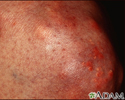Xanthoma
Skin growths - fatty; Xanthelasma
Xanthoma is a skin condition in which certain fats build up under the surface of the skin.
Causes
Xanthomas are common, especially among older adults and people with high blood lipids.
Xanthomas vary in size. Some are very small. Others are bigger than 3 inches (7.5 centimeters) in diameter. They appear anywhere on the body. But, they are most often seen on the elbows, joints, tendons, knees, hands, feet, or buttocks.
Xanthomas may be a sign of a medical condition that involves an increase in blood lipids. Such conditions include:
-
Certain
cancers
Cancers
Cancer is the uncontrolled growth of abnormal cells in the body. Cancerous cells are also called malignant cells.
Read Article Now Book Mark Article -
Diabetes
Diabetes
Diabetes is a chronic disease in which the body cannot regulate the amount of sugar in the blood.
 ImageRead Article Now Book Mark Article
ImageRead Article Now Book Mark Article - Hyperlipidemia
-
Inherited metabolic disorders such as
familial hypercholesterolemia
Familial hypercholesterolemia
Familial hypercholesterolemia is a disorder that is passed down through families. It causes LDL (bad) cholesterol level to be very high. The condit...
 ImageRead Article Now Book Mark Article
ImageRead Article Now Book Mark Article -
Primary biliary cirrhosis
Primary biliary cirrhosis
The bile ducts are tubes that move bile from the liver to the small intestine. Bile is a substance that helps with digestion. All of the bile ducts...
 ImageRead Article Now Book Mark Article
ImageRead Article Now Book Mark Article -
Pancreatitis
Pancreatitis
Acute pancreatitis is sudden swelling and inflammation of the pancreas.
 ImageRead Article Now Book Mark Article
ImageRead Article Now Book Mark Article -
Hypothyroidism
Hypothyroidism
Hypothyroidism is a condition in which the thyroid gland does not make enough thyroid hormone. This condition is often called underactive thyroid....
 ImageRead Article Now Book Mark Article
ImageRead Article Now Book Mark Article
Xanthelasma palpebra is a common type of xanthoma that appears on the eyelids. It may occur without any underlying medical condition and may not be linked with a high cholesterol or lipid level.
Symptoms
A xanthoma looks like a yellow to orange bump (papule) with defined borders. There may be several individual ones or they may form clusters.
Exams and Tests
Your health care provider will examine the skin. Usually, a diagnosis can be made by looking at your skin. A biopsy of the growth will show a fatty deposit.
Biopsy
A biopsy is the removal of a small piece of tissue for laboratory examination.
You may have blood tests done to check lipid levels, liver function, and for diabetes.
Treatment
If you have a disease that causes increased blood lipids, treating the condition may help reduce the development of xanthomas.
If the growth bothers you, your doctor may remove it by surgery or with a laser, but xanthomas may come back after surgery.
Outlook (Prognosis)
The growth is non-cancerous and painless, but may be a sign of another medical condition.
When to Contact a Medical Professional
Call your health care provider if xanthomas develop. They may indicate an underlying disorder that needs treatment.
Prevention
Control of blood lipids, including triglycerides and cholesterol levels, may help reduce development of xanthomas.
Triglycerides
The triglyceride level is a blood test to measure the amount of triglycerides in your blood. Triglycerides are a type of fat. Your body makes some t...

References
Habif TP. Cutaneous manifestations of internal disease. In: Habif TP, ed. Clinical Dermatology: A Color Guide to Diagnosis and Therapy . 6th ed. Philadelphia, PA: Elsevier Mosby; 2016:chap 26.
White LE, Horenstein MG, Shea CR. Xanthomas. In: Lebwohl MG, Heymann WR, Berth-Jones J, Coulson I, eds. Treatment of Skin Disease: Comprehensive Therapeutic Strategies . 4th ed. Philadelphia, PA: Elsevier Saunders; 2014:chap 248.
-
Xanthoma, eruptive - close-up - illustration
Xanthomas are firm, raised waxy-appearing papules (bumps) which may occur on the trunk, arms, and legs. The lesions may be skin-colored, pink or even yellow. The presence of this type of skin lesion may be associated with abnormal levels of lipids (fats) in the blood.
Xanthoma, eruptive - close-up
illustration
-
Xanthoma - close-up - illustration
Xanthomas are lesions on the skin containing cholesterol and fats. They are often associated with inherited disorders of lipid metabolism (inherited problems with the way that fats are broken down and used).
Xanthoma - close-up
illustration
-
Xanthoma - close-up - illustration
Xanthomas are raised, waxy-appearing, frequently yellowish-colored skin lesions. They may be associated with an underlying lipid (cholesterol/triglyceride) abnormality.
Xanthoma - close-up
illustration
-
Xanthoma on the knee - illustration
Xanthomas are raised, waxy-appearing, frequently yellowish-colored skin lesions, seen here on the knee. These may be associated with an underlying lipid (cholesterol/triglyceride) abnormality.
Xanthoma on the knee
illustration
-
Xanthoma, eruptive - close-up - illustration
Xanthomas are firm, raised waxy-appearing papules (bumps) which may occur on the trunk, arms, and legs. The lesions may be skin-colored, pink or even yellow. The presence of this type of skin lesion may be associated with abnormal levels of lipids (fats) in the blood.
Xanthoma, eruptive - close-up
illustration
-
Xanthoma - close-up - illustration
Xanthomas are lesions on the skin containing cholesterol and fats. They are often associated with inherited disorders of lipid metabolism (inherited problems with the way that fats are broken down and used).
Xanthoma - close-up
illustration
-
Xanthoma - close-up - illustration
Xanthomas are raised, waxy-appearing, frequently yellowish-colored skin lesions. They may be associated with an underlying lipid (cholesterol/triglyceride) abnormality.
Xanthoma - close-up
illustration
-
Xanthoma on the knee - illustration
Xanthomas are raised, waxy-appearing, frequently yellowish-colored skin lesions, seen here on the knee. These may be associated with an underlying lipid (cholesterol/triglyceride) abnormality.
Xanthoma on the knee
illustration
Review Date: 4/14/2015
Reviewed By: Kevin Berman, MD, PhD, Atlanta Center for Dermatologic Disease, Atlanta, GA. Review provided by VeriMed Healthcare Network. Also reviewed by David Zieve, MD, MHA, Isla Ogilvie, PhD, and the A.D.A.M. Editorial team.




